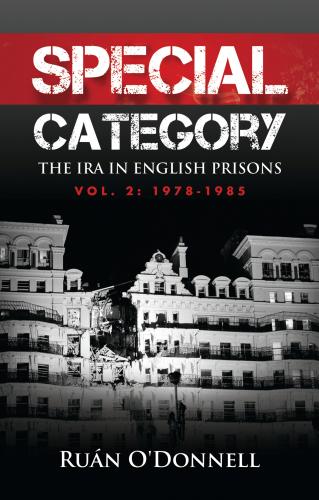Mountbatten categorized prisoners in England and Wales on a scale of A, B, C and D. Persons accorded the most restrictive rating, Category A, could in theory progress to lower levels as their sentence elapsed and parole loomed.10 Security classifications of sentenced prisoners were determined by the Home Office after trial and prior to allocation to a Dispersal Prison. A ‘special Home Office committee’ met every three weeks in St. Anne’s Gate and was understood in 1987 to solely administer those presumed to be Category A men and women. According to Tim Owen, ‘classification into the other categories is made in the various regional administrations of the Prison Department’.11 Decisions of the ‘Category A Committee’ were communicated to prisoners via relevant prison authorities in the late 1980s.12 Suspected Irish Republican Army and Irish National Liberation Army members were generally rated ‘Provisional Category A’ prior to sentencing and were evidently earmarked for assessment by the ‘special’ Home Office committee in consequence. Ratings of Category A prisoners were annually reviewed in a process reputedly informed by governors and ‘other staff at the establishment’.13 Yet, the vast majority of IRA prisoners commenced and ended their sentences at the top security tier, contrary to the concept of incremental reclassification. In 1983, the Inspector of Prisons admitted there were ‘no standard procedures’ for changing a prisoner’s category, by which time Irish republicans demonstrably fell within the discretionary area.14 Until 1992, the specific criteria used to reach such decisions remained classified, even from governors made responsible for managing their long-term detention. It transpired that persons convicted of ‘murder (except of a family member), armed robbery, rape and terrorism’, as well as ‘any offence under the Official Secrets Act’ were liable to be allocated as Category A.15 They were accompanied when moving within prisons by teams of staff members, including dog-handlers and officers required to update journals which logged prisoner location and activities in considerable detail. Cell searches and moves were far more frequent for Category A prisoners. They were obliged to receive visits from a limited pool of vetted family members under close observation. The Approved Visitors Scheme operated in an exceptionally strict fashion for the relatives of IRA prisoners, with the effect that only immediate family had any real prospect of occasional access following in-depth probing by the Special Branch.16
The 1964 edition of Prison Rules, an amended Home Office codex setting down general administrative practices in the jails of England and Wales, provided multiple means of sanctioning those deemed recalcitrant. The most commonly employed regulation, Rule 43, permitted governors to segregate a prisoner if it was believed the ‘good order and discipline’ of the prison had been threatened or was likely to be disturbed.17 A variant known as ‘Rule 43 own protection’ enabled prisoners who believed themselves to be under threat to be housed in isolation, a resort referred to as ‘going behind the door’.18 The pre-emptive form was widely applied to the IRA in English prisons who were additionally subjected to exceptionally frequent jail shifts referred to as ‘ghosting’ and twenty-eight day periods of ‘lie-downs’ in ‘local’ prisons. Temporary accommodation outside the Dispersal System entailed solitary confinement in ‘local’ prisons that were invariably ill-equipped to hold maximum-security men. Irish republicans in England were involved in numerous breaches of Prison Rules throughout the 1970s in their efforts to assert political status. Those who did not feature prominently in protest actions were still liable to be denied optimum parole conditions and, therefore, served high proportions of their sentences. The cumulative effect of such treatment resulted in the IRA being referred to as ‘Special Category A’, a term with no formal legitimacy under the 1966 Mountbatten Report. Deprivation of liberty, if an occupational inconvenience for career criminals, challenged ideologically motivated political prisoners to redirect their energies towards confronting the Dispersal System.
NOTES
1.Gerry Adams, Peace in Ireland? A broad analysis of the present situation (Belfast, 1976), p. 14. Repetition of the phrase ‘long war’ and ‘broad’ signaled the continuation of a military campaign until a wider alliance or acceptance of the position of the Republican Movement achieved meaningful negotiations.
2.See Laura K Donoghue, Counter-Terrorist Law and Emergency Powers in the United Kingdom, 1922–2000 (Dublin, 2001) and Kevin Boyle, Tom Hadden and Paddy Hillyard, Law and State, The case of Northern Ireland (London, 1975).
3.Adams, Peace in Ireland?, p. 11.
4.Adams, Peace in Ireland?, p. 13.
5.See Ruan O’Donnell, Special Category, The IRA in English Prisons (Dublin, 2012), Volume I, pp. 267–70.
6.J[ames] M G[lover], 2 November 1978, ‘Northern Ireland: Future Terrorist Trends’ in Sean Cronin, Irish Nationalism, A history of its roots and ideology (New York, 1980), p. 339. See also Ibid., pp. 339–57. The dictated IRA Army Council statement read by Jimmy Drumm at Bodenstown in June 1977 stated that the organization was committed to a ‘long haul’ campaign against the British Government. Irish Times, 29 December 1993.
7.G[lover], ‘Terrorist Trends’ in Cronin, Irish Nationalism, p. 340.
8.O’Donnell, Special Category, I, pp. 7–11.
9.Roy D King and Sandra L Resondihardjo, ‘To max or not to max: Dealing with high risk prisoners in the Netherlands and England and Wales’, Punishment and Society, 2010, Vol. 12, p. 69. See also New Society, 30 January 1975, pp. 254–5.
10.Report of Her Majesty’s Chief Inspector of Prisons, 1983 (London, 1984), p. 18.
